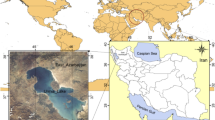Abstract
The aim of this work was to compare the adaptability of two different populations of Typha domingensis exposed to high pH and salinity. The plants were sampled from an uncontaminated natural wetland (NW) and a constructed wetland (CW) for the treatment of an industrial effluent with high pH and salinity. The plants from each population were exposed to the following combined treatments of salinity (mg l−1) and pH: 8,000/10 (values found in the CW); 8,000/7; 200/10 and 200/7 (typical values found in the NW). Chlorophyll concentration, relative growth rates (RGR) and root structure parameters (cross-sectional areas of root, stele and metaxylem vessels) were measured. Images of roots and leaves by scanning electronic microscopy (SEM) were obtained, and X-ray microanalysis in different tissues was carried out. In all treatments, the RGR and chlorophyll increase were significantly lower in the plants from the NW than in the plants from the CW. However, stress was observed when the plants from the CW were exposed to treatment 200/7. In treatment 8,000/10 the tissues of the plants from the NW showed severe damages. The root structure of plants from the CW was modified by salinity, while pH did not produce changes. In plants from the CW there were no differences between Na concentration in leaves of the treatments 8,000/10 and 200/7, indicating that Na was not transported to leaves. The CW population already possesses physiological and morphological adaptations due to the extreme conditions of pH and salinity. Because of its adaptive capacity, T. domingensis is an efficient species to treat wastewater of high pH and salinity.




Similar content being viewed by others
References
Amarante L, Lima JD, Sodek L (2006) Grow and stress conditions cause similar changes in xilem amino acids for different legume species. J Exp Bot 58:123–129
APHA (1998) Standard methods for the examination of water and wastewater. American Public Health Association, New York
D’Ambrogio de Argüeso A (1986) Manual de técnicas en histología vegetal. Hemisfero Sur S.A, Buenos Aires
Dyhr-Jensen K, Brix H (1996) Effects of pH on ammonium uptake by Typha latifolia L. Plant Cell Environ 19:1431–1436
Glenn E, Thompson LT, Frye R, Riley J, Baumgartner D (1995) Effects of salinity on growth and evapotranspiration of Typha domingensis Pers. Aquat Bot 52:75–91
Hadad HR, Maine MA, Bonetto C (2006) Macrophyte growth in a pilot-scale constructed wetland for industrial wastewater treatment. Chemosphere 63(10):1744–1753
Hammer DA (1989) Constructed wetlands for wastewater treatment. Lewis, Chelsea
Hester WM, Mendessohn IA, McKee KL (2001) Species and population variation to salinity stress in Panicum hemitomon, Spartina patens, and Spartina alterniflora: morphological and physiological contraints. Environ Exp Bot 46:277–297
Kadlec RH, Wallace SD (2009) Treatment wetlands, 2nd edn. CRC Press, Boca Raton
Kadlec RH, Knight RL, Vymazal J, Brix H, Cooper P, Haberl R (2000) Constructed wetlands for pollution control: processes, performance, design and operation. IWA specialist group on use of macrophytes in water pollution control. International Water Association
Macek P, Rejmánková E (2007) Response of emergent macrophytes to experimental nutrient and salinity additions. Funct Ecol 21:478–488
Maine MA, Suñé N, Hadad RH, Sánchez GC, Bonetto C (2009) Influence of vegetation on the removal of heavy metals and nutrients in a constructed wetland. J Environ Manag 90:355–363
Munns R (2002) Comparative physiology of salt and water stress. Plant Cell Environ 25:239–250
Munns R, Greenway H (1980) Mechanisms of salt tolerance in non-halophytes. Annu Rev Plant Physiol 31:149–190
Munns R, Greenway H, Kirst GO (1993) Halotolerant eukaryotes. In: Lange OL, Nobel PS, Osmond CB, Ziegler HH (eds) Encyclopedia of Plant Physiology (New Series, Vol. 12C). Springer Verlag, Berlin, pp 59–135
Nilratnisakorn S, Thiravetyan P, Nakbanpote W (2007) Synthetic reactive dye wastewater treatment by narrow-leaved cattails (Typha angustifolia Linn.): effects of dye, salinity and metals. Sci Total Environ 384:67–76
Parida AK, Das AB (2005) Salt tolerance and salinity effects on plants: a review. Ecotoxicol Environ Saf 60:324–349
Popp M (1995) Salt resistance in herbaceous halophytes and mangroves. Prog Bot 56:415–429
Suñé N, Sánchez G, Caffaratti S, Maine MA (2007) Cadmium and chromium removal kinetics from solution by two aquatic macrophytes. Environ Poll 145(2):467–473
Thomson WW (1975) The structure and function of salt glands. In: Pojkoff Mayber A, Gale J (eds) Biotechnology in agriculture and foresty. Medical and aromatic plant II. Springer, Berlin, pp 118–148
Vymazal J, Brix H, Cooper PF, Green MB, Haberl R (1998) Constructed wetlands for wastewater treatment in Europe. Backhuys, Leiden
Wahl S, Ryser P, Edwards PJ (2001) Phenotypic plasticity of grass root anatomy in response to light intensity and nutrient supply. Ann Bot 88:1071–1078
Westlake DF (1974) Macrophytes. In: Vollenweider RA (ed) A manual on methods for measuring primary production in aquatic environments. IBP Handbook No 12, 2nd edn. International Biological Programme, Blackwell Scientific Publications, Oxford, pp 32–42
Acknowledgments
The authors thank Consejo Nacional de Investigaciones Científicas y Técnicas (CONICET) and Universidad Nacional del Litoral (UNL), CAI+D Project for providing funds for this work.
Author information
Authors and Affiliations
Corresponding author
Rights and permissions
About this article
Cite this article
Mufarrege, M.M., Di Luca, G.A., Hadad, H.R. et al. Adaptability of Typha domingensis to high pH and salinity. Ecotoxicology 20, 457–465 (2011). https://doi.org/10.1007/s10646-011-0598-0
Accepted:
Published:
Issue Date:
DOI: https://doi.org/10.1007/s10646-011-0598-0




